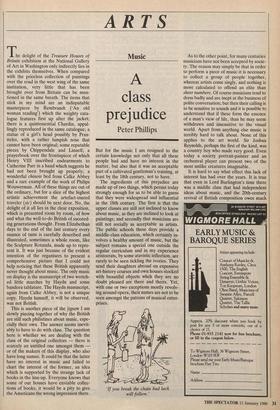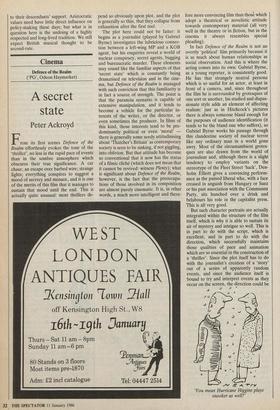ARTS
Music
A class prejudice
Peter Phillips
The delight of the Treasure Houses of Britain exhibition at the National Gallery of Art in Washington only indirectly lies in the exhibits themselves. When compared with the priceless collection of paintings over the road in the west wing of the same institution, very little that has been brought over from Britain can be men- tioned in the same breath. The items that stick in my mind are an indisputable masterpiece by Rembrandt (`An old woman reading') which the weighty cata- logue features first up after the jacket; there is a quintessential Chardin, appal- lingly reproduced in the same catalogue; a statue of a girl's head possibly by Prax- iteles, with a rather lumpish nose that cannot have been original; some reputable pieces by Chippendale and Linnell; a prayerbook over the frontispiece of which Henry VIII inscribed endearments to Catherine Parr in a hand which suggests he had not been brought up properly; a wonderful chinois bed from Calke Abbey and a rare example of the work of Philips Wouwerman. All of these things are out of the ordinary, but for a slice of the highest artistic achievement the artefact-inured traveler (sic) should be next door. No, the delight of it all lies in the clear exposition, which is presented room by room, of how and what the well-to-do British of succeed- ing generations thought. From Elizabethan days to the end of the last century every nuance of taste is carefully described and illustrated, sometimes a whole room, like the Sculpture Rotunda, made up to repre- sent it. It was just because of the evident intention of the organisers to present a comprehensive picture that I could not help noticing that these British apparently never thought about music. The only music on display is the manuscript of two wretch- ed little marches by Haydn and some bandora tablature. The Haydn manuscript, again from Calke Abbey, is not a unique copy. Haydn himself, it will be observed, was not British.
This is another piece of the jigsaw I am slowly piecing together of why the British are still such philistines about music, espe- cially their own. The answer seems inevit- ably to have to do with class. The question here is whether we are dealing with the class of the original collectors — there is scarcely an untitled one amongst them or of the makers of this display, who also have long names. It could be that the latter have no interest in music and failed to chart the interest of the former, an idea which is supported by the strange lack of books in the line-up. Everyone knows that some of our houses have enviable collec- tions of books; it would be a pity to give the Americans the wrong impression there. But for the music I am resigned to the certain knowledge not only that all these people had and have no interest in the matter, but also that it was an acceptable part of a cultivated gentleman's training, at least by the 18th century, not to have.
The ingredients of this prejudice are made up of two things, which persist today strongly enough for us to be able to guess that they were widespread and influential in the 18th century. The first is that the upper classes are still not inclined to know about music, as they are inclined to look at paintings; and secondly that musicians are still not socially as acceptable as artists. The public schools these days provide a middle-class education, which certainly in- volves a healthy amount of music, but the subject remains a special one outside the regular curriculum and in my experience aristocrats, by some atavistic inflection, are rarely to be seen tickling the ivories. They send their daughters abroad on expensive art-history courses and own houses stocked with beautiful objects whch they are no doubt pleased are there and theirs. Yet, with one or two exceptions mostly revolv- ing around opera, their names are not to be seen amongst the patrons of musical enter- prises.
'If you break the chain bad luck will follow.' As to the other point, for many centuries musicians have not been accepted by socie- ty. The reason may simply be that in order to perform a piece of music it is necessary to collect a group of people together, whereas artists come singly, and nothing is more calculated to offend an elite than sheer numbers. Of course musicians tend to dress badly and are inept at the business of polite conversation; but then their calling is to be sensitive to sounds and it is possible to understand that if these form the essence of a man's view of life, than he may seem withdrawn and insensitive to the visual world. Apart from anything else music is terribly hard to talk about. None of this applies to the art world. Sir Joshua Reynolds, perhaps the first of the kind, was a country boy who made very good. Even today a society portrait-painter and an orchestral player can present two of the most unlike creatures imaginable.
It is hard to say what effect this lack of interest has had over the years. It is true that even in Lord Burlington's time there was a middle class that had independent ideas about music, and the 20th-century revival of British composition owes much to their descendants' support. Aristocratic values need have little direct influence on policy-making these days; but what is in question here is the undoing of a highly respected and long-lived tradition. We still expect British musical thought to be second-rate.



























































 Previous page
Previous page